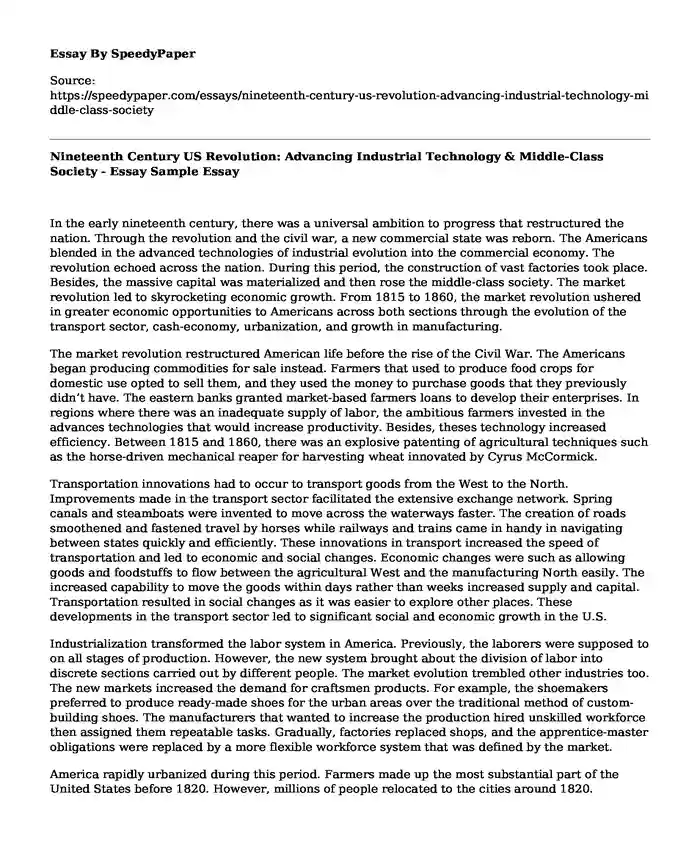
| Type of paper: | Essay |
| Categories: | Technology Industrial revolution |
| Pages: | 4 |
| Wordcount: | 910 words |
In the early nineteenth century, there was a universal ambition to progress that restructured the nation. Through the revolution and the civil war, a new commercial state was reborn. The Americans blended in the advanced technologies of industrial evolution into the commercial economy. The revolution echoed across the nation. During this period, the construction of vast factories took place. Besides, the massive capital was materialized and then rose the middle-class society. The market revolution led to skyrocketing economic growth. From 1815 to 1860, the market revolution ushered in greater economic opportunities to Americans across both sections through the evolution of the transport sector, cash-economy, urbanization, and growth in manufacturing.
The market revolution restructured American life before the rise of the Civil War. The Americans began producing commodities for sale instead. Farmers that used to produce food crops for domestic use opted to sell them, and they used the money to purchase goods that they previously didn’t have. The eastern banks granted market-based farmers loans to develop their enterprises. In regions where there was an inadequate supply of labor, the ambitious farmers invested in the advances technologies that would increase productivity. Besides, theses technology increased efficiency. Between 1815 and 1860, there was an explosive patenting of agricultural techniques such as the horse-driven mechanical reaper for harvesting wheat innovated by Cyrus McCormick.
Transportation innovations had to occur to transport goods from the West to the North. Improvements made in the transport sector facilitated the extensive exchange network. Spring canals and steamboats were invented to move across the waterways faster. The creation of roads smoothened and fastened travel by horses while railways and trains came in handy in navigating between states quickly and efficiently. These innovations in transport increased the speed of transportation and led to economic and social changes. Economic changes were such as allowing goods and foodstuffs to flow between the agricultural West and the manufacturing North easily. The increased capability to move the goods within days rather than weeks increased supply and capital. Transportation resulted in social changes as it was easier to explore other places. These developments in the transport sector led to significant social and economic growth in the U.S.
Industrialization transformed the labor system in America. Previously, the laborers were supposed to on all stages of production. However, the new system brought about the division of labor into discrete sections carried out by different people. The market evolution trembled other industries too. The new markets increased the demand for craftsmen products. For example, the shoemakers preferred to produce ready-made shoes for the urban areas over the traditional method of custom-building shoes. The manufacturers that wanted to increase the production hired unskilled workforce then assigned them repeatable tasks. Gradually, factories replaced shops, and the apprentice-master obligations were replaced by a more flexible workforce system that was defined by the market.
America rapidly urbanized during this period. Farmers made up the most substantial part of the United States before 1820. However, millions of people relocated to the cities around 1820. Alongside the Americans, the Irish and German immigrants flooded the cities while looking for jobs in the developing industries. This salaried workforce system played a crucial role in the transformation of the society as it brought about the first American middle class, comprised of skilled laborers and white-collar workers. The various reform movements were pushed for by this growing middle-class population. These reforms were such as eliminating prostitution, banning slavery, enhancing the education system, and reducing alcohol consumption. Also, religious revivalism impacted the wellbeing of Americans in all regions.
Although the industrialists applauded the new labor system, it resulted in a powerless class of laborers. Seth Luther, a labor activist, defined the ongoing capitalism as a cruel system that enabled the rich to be more comfortable while the poor either worked or starved. Most Americans started on their careers as waged laborers with the hope that with hard work, they would be financially stable. Moving up the economic ladder was such a glorified idea. However, the commercial economy did not promise that kind of growth. The employees worked for long hours, in risky working conditions for low wages. Additionally, they were prone to uncertainty and being powerless at their places of work. They formed labor unions to bargain for better pay and working conditions.
The development of long-distance trade was considered a market revolution by historians. There was an economy transition into one that was based upon cash and exchange of goods and services. This significantly impacted the economy in that numerous Americans participated in the abruptly growing cash economy (Roark et al. 264). The growth in manufacturing generated the salaried workforce system. The Americans adjusted their farms and businesses to suit the market changes.
During the nineteenth century, there was an accelerated economic growth due to market revolution. Those that offered waged labor became the new middle class in the society. Developed the transport sector, advanced machinery, and labor organizations blended into a national industrial operation. Even though industrialization and the cash economy connected the diverse areas, it created social classifications. Additionally, the changes brought about crucial social reforms. The market evolution had a significant impact on the social and economic growth of the United States.
Works Cited
Johnson et al. “10- 13.” The American Promise: a History of the United States, by James L. Roark, Bedford/St. Martin’s, Boston, MA, 2020, pp. 233–337.
Delfino, Susanna, et al. Southern Society and Its Transformations, 1790-1860. University of Missouri Press, 2011.
Cite this page
Nineteenth Century US Revolution: Advancing Industrial Technology & Middle-Class Society - Essay Sample. (2023, Aug 16). Retrieved from https://speedypaper.net/essays/nineteenth-century-us-revolution-advancing-industrial-technology-middle-class-society
Request Removal
If you are the original author of this essay and no longer wish to have it published on the SpeedyPaper website, please click below to request its removal:
Popular categories




